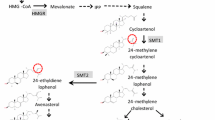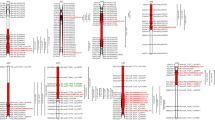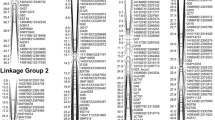Abstract
Increasing oil content and improving the fatty acid composition in the seed oil are important breeding goals for rapeseed (Brassica napus L.). The objective of the study was to investigate a possible relationship between fatty acid composition and oil content in an oilseed rape doubled haploid (DH) population. The DH population was derived from a cross between the German cultivar Sollux and the Chinese cultivar Gaoyou, both having a high erucic acid and a very high oil content. In total, 282 DH lines were evaluated in replicated field experiments in four environments, two each in Germany and in China. Fatty acid composition of the seed oil was analyzed by gas liquid chromatography and oil content was determined by NIRS. Quantitative trait loci (QTL) for fatty acid contents were mapped and their additive main effects were determined by a mixed model approach using the program QTLMapper. For all fatty acids large and highly significant genetic variations among the genotypes were observed. High heritabilities were determined for oil content and for all fatty acids (h 2 = 0.82 to 0.94), except for stearic acid content (h 2= 0.38). Significant correlations were found between the contents of all individual fatty acids and oil content. Closest genetic correlations were found between oil content and the sum of polyunsaturated fatty acids (18:2 + 18:3; r G = −0.46), the sum of monounsaturated fatty acids (18:1 + 20:1 + 22:1; r G = 0.46) and palmitic acid (16:0; r G = −0.34), respectively. Between one and eight QTL for the contents of the different fatty acids were detected. Together, their additive main effects explained between 28% and 65% of the genetic variance for the individual fatty acids. Ten QTL for fatty acid contents mapped within a distance of 0 to 10 cM to QTL for oil content, which were previously identified in this DH population. QTL mapped within this distance to each other are likely to be identical. The results indicate a close interrelationship between fatty acid composition and oil content, which should be considered when breeding for increased oil content or improved oil composition in rapeseed.
Similar content being viewed by others
Abbreviations
- MUFA:
-
monounsaturated fatty acids
- ACP:
-
acyl carrier protein
References
Appelqvist L-A (1968) Lipids in Cruciferae. III. Fatty acid composition of diploid and tetraploid seeds of Brassica campestris and Sinapis alba grown under two climatic extremes. Physiol Plant 21:615–625
Bonaventure G, Salas JJ, Pollard MR, Ohlrogge JB (2003) Disruption of the FATB gene in Arabidopsis demonstrates an essential role of saturated fatty acids in plant growth. Plant Cell 15:1020–1033
Burns MJ, Barnes SR, Bowman JG, Clarke MHE, Werner CP, Kearsey MJ (2003) QTL analysis of an intervarietal set of substitution lines in Brassica napus: (I) Seed oil content and fatty acid composition. Heredity 90:39–48
Chen JL, Beversdorf WD (1990) Fatty acid inheritance in microspore-derived populations of spring rapeseed (Brassica napus L.). Theor Appl Genet 80:465–469
Cheung WY, Landry BS (1998) Molecular mapping of seed quality traits in Brassica juncea L. Czern. and Coss. Proc Int Symp on Brassica. Acta Hort 459:139–147
Delourme R , Falentin C, Huteau V, Clouet V, Horvais R, Gandon B, Specel S, Hanneton L, Dheu JE, Deschamps M, Margale E, Vincourt P, Renard M (2006) Genetic control of oil content in oilseed rape (Brassica napus L.) Theor Appl Genet 113:1331–1345
Dörmann P, Voelker TA, Ohlrogge JB (2000) Accumulation of palmitate in Arabidopsis mediated by the Acyl–Acyl Carrier Protein Thioesterase FATB1. Plant Physiol 123:637–643
Ecke W, Uzunova M, Weißleder K (1995) Mapping the genome of rapeseed (Brassica napus L.). II. Localization of genes controlling erucic acid synthesis and seed oil content. Theor Appl Genet 91:972–977
Hill J, Becker HC, Tigerstedt PMA (eds) (1998) Quantitative and ecological aspects of plant breeding. Chapman & Hall, London
Hobbs DH, Flintham JE, Hills MJ (2004) Genetic control of storage oil synthesis in seeds of Arabidopsis. Plant Physiol 136:3341–3349
Hu X, Sullivan-Gilbert M, Gupta M, Thompson SA (2006) Mapping of the loci controlling oleic acid and linolenic acid contents and development of fad2 and fad3 allele-specific markers in canola (Brassica napus L.). Theor Appl Genet 113:497–507
James DW, Lim E, Keller J, Plooy I, Ralston E, Dooner HK (1995) Direct tagging of the Arabidopsis FATTY ACID ELONGATION1 (FAE1) gene with the maize transposon activator. The Plant Cell 7:309–319
Jönsson R (1977) Erucic acid heredity in rapeseed (Brassica napus L. and Brassica campestris L.). Hereditas 86:159–170
Jourdren C, Barret P, Horvais R, Delourme R, Renard M (1996a) Identification of RAPD markers linked to linolenic acid genes in rapeseed. Euphytica 90:351–357
Jourdren C, Barret P, Brunel D, Delourme R, Renard M (1996b) Specific molecular marker of the genes controlling linolenic acid content in rapeseed. Theor Appl Genet 93:512–518
Kondra ZP, Stefansson BR (1965) Inheritance of erucic and eicosenoic acid content of rape-seed oil (Brassica napus L.). Can J Genet Cytol 7:505–510
Mahmood T, Ekuere U, Yeh F, Good AG, Stringam GR (2003) RFLP linkage analysis and mapping genes controlling the fatty acid profile of Brassica juncea using reciprocal DH populations. Theor Appl Genet 107:283–290
Mekhedov S, de Ilarduya OM, Ohlrogge J (2000) Toward a functional catalog of the plant genome: a survey of genes for lipid biosynthesis. Plant Physiol 122:389–402
Möllers C (2004) Potential and future prospects for rapeseed oil. In: Gunstone FD (ed) Rapeseed and canola oil—production, processing, properties and uses. Blackwell Publishing, Oxford, UK, pp186–217
Möllers C, Schierholt A (2002) Genetic variation of palmitate and oil content in a winter oilseed rape doubled haploid population segregating for oleate content. Crop Sci 42:379–384
Parkin IAP, Sharpe AG, Keith DJ, Lydiate DJ (1995) Identification of the A and C genomes of amphidiploid Brassica napus (oilseed rape). Genome 38:1122–1131
Qiu D, Morgan C, Shi J, Long Y, Liu J, Li R, Zhuang X, Wang Y, Tan X, Dietrich E, Weihmann T, Everett C, Vanstraelen S, Beckett P, Fraser F, Trick M, Barnes S, Wilmer J, Schmidt R, Li J, Meng J, Bancroft I (2006) A comparative linkage map of oilseed rape and its use for QTL analysis of seed oil and erucic acid content. Theor Appl Genet 114:67–80
Rücker B, Röbbelen G (1996) Impact of low linolenic acid content on seed yield of winter oilseed rape (Brassica napus L.). Plant Breed 115:226–230
Scarth R, Tang J (2006) Modification of Brassica oil using conventional and transgenic approaches. Crop Sci 46:1225–1236
Scheffler JA, Sharpe AG, Schmidt H, Sperling P, Parkin IAP, Lühs W, Lydiate DJ, Heinz E (1997) Desaturase multigene families of Brassica napus arose through genome duplication. Theor Appl Genet 94:583–591
Schierholt A, Becker HC, Ecke W (2000) Mapping a high oleic acid mutation in winter oilseed rape (Brassica napus L.). Theor Appl Genet 101:897–901
Spiekermann P (2003) Isolierung und Charakterisierung von Genkopien der mikrosomalen Oleatdesaturase FAD2 aus Brassica napus L. sowie Entwicklung transgener Rapspflanzen mit erhöhtem Ölsäuregehalt im Samen. Dissertation Fachbereich Biologie, Universität Hamburg
Tanhuanpää P, Schulman A (2002) Mapping of genes affecting linolenic acid content in Brassica rapa ssp. oleifera. Mol Breed 10:51–62
Thormann CE, Romero J, Mantet J, Osborn TC (1996) Mapping loci controlling the concentrations of erucic and linolenic acids in seed oil of Brassica napus L. Theor Appl Genet 93:282–286
Tillmann P (2007) www.vdlufa.de/nirs cited 21 March 2007
Utz HF (1994) PLABCOV (Version 1B(L)); A computer program for statistical covariance analysis of plant breeding experiments. Institute of Plant Breeding, Seed Science, and Population Genetics, University of Hohenheim, Stuttgart, Germany
Utz HF (2007) PLABSTAT (Version 2N); A computer program for the computation of variances and covariances. Institute of Plant Breeding, Seed Science, and Population Genetics, University of Hohenheim, Stuttgart, Germany (http://www.uni-hohenheim.de/ipspwww/soft.html cited 21 March 2007)
Uzunova MI, Ecke W, Weissleder K, Röbbelen G (1995) Mapping the genome of rapeseed (Brassica napus L.) I. Construction of an RFLP linkage map and localization of QTLs for seed glucosinolate content. Theor Appl Genet 90:194–204
Voelker TA (1996) Plant Acyl-ACP thioesterases: chain length determining enzymes in plant fatty acid biosynthesis. In: Stelow JK (eds) Genetic engineering, vol 18. Plenum Press, New York, pp111–133
Wang DL, Zhu J, Li ZK, Paterson AH (1999) Mapping of QTL with epistatic effects and QTL × environment interactions by mixed model approaches. Theor Appl Genet 99:1255–1264
Zhao J (2002) QTLs for oil content and their relationships to other agronomic traits in a European × Chinese oilseed rape population. Dissertation, Faculty of Agriculture, University of Göttingen. http://webdoc.sub.gwdg.de/diss/2002/zhao_jianyi/zhao_jianyi.pdf
Zhao J, Becker HC, Zhang D, Zhang Y, Ecke W (2005) Oil content in a European × Chinese rapeseed population: QTL with additive and epistatic effects and their genotype–environment interactions. Crop Sci 45:51–59
Zhao J, Becker HC, Zhang D, Zhang Y, Ecke W (2006) Conditional QTL mapping of oil content in rapeseed with respect to protein content and traits related to plant development and grain yield. Theor Appl Genet 113:33–38
Acknowledgements
The technical assistance of Uwe Ammermann in analysing the fatty acid composition is greatly acknowledged. This research was financially supported by the European Commission (cooperative project IC18-CT 97-0172) and National Natural Science Foundation (No.30470985).
Author information
Authors and Affiliations
Corresponding author
Rights and permissions
About this article
Cite this article
Zhao, J., Dimov, Z., Becker, H.C. et al. Mapping QTL controlling fatty acid composition in a doubled haploid rapeseed population segregating for oil content. Mol Breeding 21, 115–125 (2008). https://doi.org/10.1007/s11032-007-9113-y
Received:
Accepted:
Published:
Issue Date:
DOI: https://doi.org/10.1007/s11032-007-9113-y




